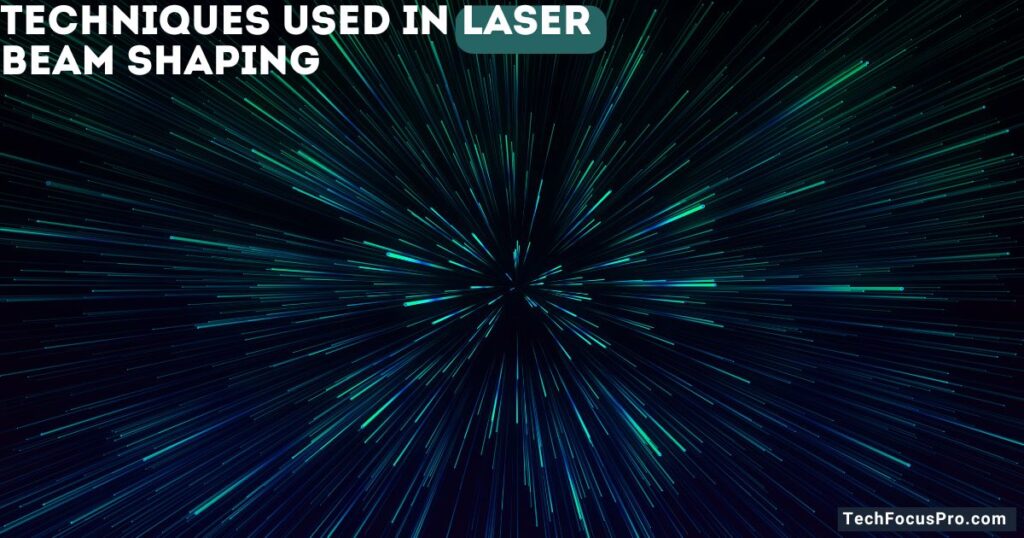Laser Beam Shaping Techniques

Laser beam shaping is the process of transforming a laser beam into a desired shape or size. This technique allows lasers to be more efficient and effective for specific tasks.
The laser’s original shape, which is usually round, can be altered into various forms, such as square, rectangular, or even more complex shapes. This transformation is critical because it ensures that the laser performs optimally for its needed job.
Most laser systems emit light radiation mathematically understood as a Gaussian distribution pattern. This distribution pattern has the highest irradiance level at the centre, followed by smoothly decaying edges.
The problem with this intensity distribution pattern is that a significant amount of energy gets wasted due to the infinite expansion of edges. Therefore, it is important to shape the laser beams so that the output beams exhibit a uniform intensity distribution pattern.
Diffractive optical elements, or DOEs, are unique optical components that modify or transform an input beam using the diffraction principle. Diffractive optical elements can perform different laser beam transformations, such as
A. Spatial Laser Beam Shaping
In spatial beam shaping, diffractive optical elements convert a Gaussian beam profile into a uniform spot with a Flat Top intensity distribution pattern. They also transform the beam profile into various geometrical distribution patterns with sharp borders.
B. Beam Splitting
Beam-splitting can split a single laser beam into multiple output beams with the same characteristics as the original beam.
C. Focal Beam Shaping
Through focal beam shaping, diffractive optical elements modify an incident beam along its propagation axis. The optical elements stretch the beam to elongate the input beam waist.
The Role of Diffractive Optical Elements in Laser Beam Shaping
While most laser beams emit a Gaussian intensity profile with a non-uniform intensity distribution pattern, this results in a significant energy loss that is undesirable for various laser applications. Diffractive optical elements of DOEs modify the beam pattern of the input beam into a uniform intensity distribution pattern with sharp edges.
A Flat Top beam shaper shapes an input laser beam by converting its non-uniform distribution pattern into a beam pattern with a uniform and constant irradiance level and sharp edges. An important application of flat-top beam shaping is body contouring or reducing fat cells under the lower skin. Laser beam shaping has significant applications in areal skin treatments like tattoo removal.
Diffractive optical elements can shape the input beam into a desirable distribution pattern of any geometrical shape. However, rectangular and hexagonal shapes are the two most convenient for the laser beam shaping applications mentioned above.
Beam splitting is another function of laser beam shaping with crucial aesthetic medicine applications in fractional treatments. This application involves diffractive optical elements splitting a single input beam into an array of output beams.
Diffractive optical elements can also arrange the output beams in any order and with any number of spots.
Techniques Used in Laser Beam Shaping

Laser beam shaping involves different techniques that help change the shape and size of a laser beam. Here’s a closer look at some standard methods used:
Refractive Methods
Refractive methods are based on bending light using materials like lenses and prisms. When a laser beam passes through a lens, it can be focused to a small point or spread out to cover a larger area. Prisms, on the other hand, can change the direction of the laser beam by refracting or bending the light.
For example, a simple magnifying glass is a lens that can make a laser beam concentrate at a small spot, making it more powerful.
Diffractive Methods
Diffractive methods involve splitting and rearranging the light using unique patterns, such as diffraction gratings and holographic techniques. Diffraction gratings are surfaces with many tiny, closely spaced lines that cause light to spread out in different directions.
This method resembles how a CD or DVD can create rainbow patterns when light hits it. Holographic techniques use patterns to shape the laser beam into complex forms, like creating a hologram or a 3D image.
Reflective Methods
Reflective methods use mirrors and reflective surfaces to control the direction and shape of a laser beam. When a laser beam hits a mirror, it bounces off in a different direction.
By strategically placing mirrors, you can direct the laser beam where needed, much like using a mirror to reflect sunlight into another part of a room. Reflective methods can also involve specially shaped mirrors to effectively focus or spread the laser beam.
Each of these methods is important because they allow the laser to be tailored for specific needs, whether in cutting materials precisely, performing delicate surgeries, or even in everyday devices.
Advanced Laser Beam Shaping Technologies
Advanced laser beam shaping technologies offer sophisticated methods for controlling and manipulating laser beams more precisely. Two important techniques in this field are computer-generated holography and spatial light modulators.
Computer-Generated Holography
Computer-generated holography involves creating holograms using computer technology. A hologram is a 3D image created by light. In this technique, computers design images that can control how a laser beam is shaped.
These images are called holographic patterns, and when a laser beam passes through these patterns, it shapes the beam into the desired form. This is especially useful in complex tasks like making detailed 3D images or directing laser beams in advanced medical devices.
Spatial Light Modulators
The function of spatial light modulators in dynamic beam shaping is essential. These gadgets have the ability to instantly alter the direction and form of a laser beam. Think of them as incredibly fast projectors that can rapidly alter the images they display.
A spatial light modulator allows the shape of a laser beam to be changed instantly, enabling precise control and rapid alterations. Applications like communication devices and scanning systems, where the laser beam’s form needs to be modified quickly, require this technology.
Now you are familiar with Laser Beam Shaping. You can also explore Intelliscient Technologies: Impulse of Change in the Tech Industry.
All You Need to Ask About Laser Beam Shaping
What is laser beam shaping?
Laser beam shaping refers to changing the spatial distribution of a laser beam’s intensity. This is done to meet specific requirements for various applications, improving performance and efficiency in manufacturing, medicine, and research.
Why is laser beam shaping important?
Laser beam shaping is crucial because it allows for precise control over laser beams, which is essential in tasks that require high accuracy, such as cutting materials, conducting delicate surgeries, or manipulating small particles in scientific experiments.
What are the applications of laser beam shaping?
Laser beam shaping is used in many different fields. In industry, it helps process materials and manufacture products precisely, like cutting and welding metals. In medicine, it is used in laser surgeries and skin treatments where accuracy is very important. In scientific research, it allows for controlling and studying tiny particles by trapping or moving them with light.
Why is beam shaping required for the laser beam?
Beam shaping is needed because it helps make the laser beam more effective for whatever task it’s used for. For example, if you need to cut an exact shape out of a material, shaping the laser beam can help you get the precise cut. It’s also important to ensure safety and effectiveness in other areas, like medical procedures.
What is the principle of a beam shaper?
A beam shaper modifies the spread and form of a laser beam to tailor it to a specific application, such as distributing it across a large area or concentrating it onto a single point. Think of it as altering the shape of the water spray with a garden hose by using different nozzles. Similar work is done by beam shapers but with laser light.
What are the main techniques used in laser beam shaping?
The main methods for modifying the direction and shape of a laser beam are:
- Refractive methods (using lenses and prisms).
- Diffractive methods (using diffraction gratings and holographic techniques).
- Reflective methods (using mirrors and reflective surfaces).
How do spatial light modulators contribute to laser beam shaping?
Spatial light modulators are devices that dynamically modify the shape and direction of a laser beam in real-time. They offer rapid and precise control, which is essential for applications that require fast adjustments, such as communication technologies or scanning systems.






